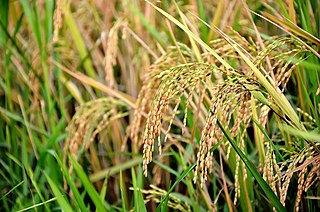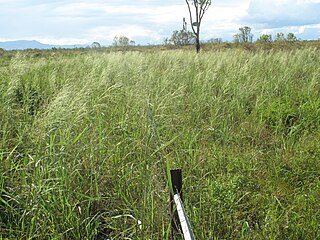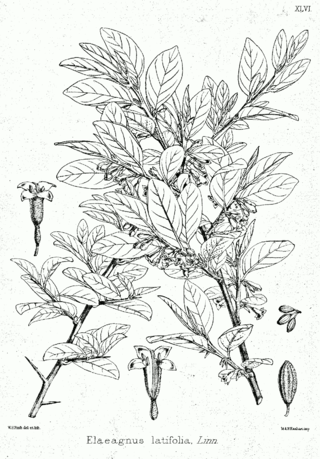Related Research Articles

Rice is a cereal grain and in its domesticated form is the staple food of over half of the world's population, particularly in Asia and Africa. Rice is the seed of the grass species Oryza sativa —or, much less commonly, Oryza glaberrima. Asian rice was domesticated in China some 13,500 to 8,200 years ago; African rice was domesticated in Africa about 3,000 years ago. Rice has become commonplace in many cultures worldwide; in 2021, 787 million tons were produced, placing it fourth after sugarcane, maize, and wheat. Only some 8% of rice is traded internationally. China, India, and Indonesia are the largest consumers of rice. A substantial amount of the rice produced in developing nations is lost after harvest through factors such as poor transport and storage. Rice yields can be reduced by pests including insects, rodents, and birds, as well as by weeds, and by diseases such as rice blast. Traditional rice polycultures such as rice-duck farming, and modern integrated pest management seek to control damage from pests in a sustainable way.

Oryza is a genus of plants in the grass family. It includes the major food crop rice. Members of the genus grow as tall, wetland grasses, growing to 1–2 metres (3–7 ft) tall; the genus includes both annual and perennial species.

Wild rice, also called manoomin, mnomen, psíŋ, Canada rice, Indian rice, or water oats, is any of four species of grasses that form the genus Zizania, and the grain that can be harvested from them. The grain was historically and is still gathered and eaten in North America and, to a lesser extent, China, where the plant's stem is used as a vegetable.

Oryza sativa, having the common name Asian cultivated rice, is the much more common of the two rice species cultivated as a cereal, the other species being O. glaberrima, African rice. It was first domesticated in the Yangtze River basin in China 13,500 to 8,200 years ago.

Bactris gasipaes is a species of palm native to the tropical forests of Central and South America. It is well spread in these regions, where it is often cultivated by smallholders in agroforestry systems or more rarely, in monoculture. Common names include peach palm in English, among others used in South American countries. It is a long-lived perennial plant that is productive for 50 to 75 years on average. Its population has an important genetic diversity, leading to numerous fruits, colors, and qualities. The fruits are edible and nutritious but need to be cooked for 30 minutes to five hours. They also benefit many animals in the wild. Peach-palms are also cultivated for the heart of palm, and the trunk can make valuable timber.

Typha latifolia is a perennial, herbaceous flowering wetland plant in the family Typhaceae. It is known commonly as bulrush ; in North America, it is often referred to as broadleaf cattail, or simply as cat-tail or cattail reed. It is native throughout most of temperate Eurasia and North America, and found more locally in Africa and South America. The genome of Typha latifolia was published in 2022.

Indigenous cuisine of the Americas includes all cuisines and food practices of the Indigenous peoples of the Americas. Contemporary Native peoples retain a varied culture of traditional foods, along with the addition of some post-contact foods that have become customary and even iconic of present-day Indigenous American social gatherings. Foods like cornbread, turkey, cranberry, blueberry, hominy, and mush have been adopted into the cuisine of the broader United States population from Native American cultures.

Agriculture began independently in different parts of the globe, and included a diverse range of taxa. At least eleven separate regions of the Old and New World were involved as independent centers of origin. The development of agriculture about 12,000 years ago changed the way humans lived. They switched from nomadic hunter-gatherer lifestyles to permanent settlements and farming.

The Eastern Agricultural Complex in the woodlands of eastern North America was one of about 10 independent centers of plant domestication in the pre-historic world. Incipient agriculture dates back to about 5300 BCE. By about 1800 BCE the Native Americans of the woodlands were cultivating several species of food plants, thus beginning a transition from a hunter-gatherer economy to agriculture. After 200 BCE when maize from Mexico was introduced to the Eastern Woodlands, the Native Americans of the eastern United States and adjacent Canada slowly changed from growing local indigenous plants to a maize-based agricultural economy. The cultivation of local indigenous plants other than squash and sunflower declined and was eventually abandoned. The formerly domesticated plants returned to their wild forms.

Oryza barthii, also called Barth's rice, wild rice, or African wild rice, is a grass in the rice genus Oryza. It is an annual, erect to semierect grass. It has leaves with a short ligule, and panicles that are compact to open, rarely having secondary branching. The inflorescence structure are large spikelets, 7.7–12.3 millimetres long and 2.3–3.5 millimetres wide, with strong awns, usually red. The inflorescences have anthers 1.5–3 millimetres long.

Oryza rufipogon is a species of flowering plant in the family Poaceae. It is known as brownbeard rice, wild rice, and red rice. In 1965, Oryza nivara was separated off from O. rufipogon. The separation has been questioned, and now many sources consider O. nivara to be a synonym of O. rufipogon. O. nivara may be treated as the annual form of O. rufipogon.

Oryza glaberrima, commonly known as African rice, is one of the two domesticated rice species. It was first domesticated and grown in West Africa around 3,000 years ago. In agriculture, it has largely been replaced by higher-yielding Asian rice, and the number of varieties grown is declining. It still persists, making up an estimated 20% of rice grown in West Africa. It is now rarely sold in West African markets, having been replaced by Asian strains.
Plant breeding started with sedentary agriculture, particularly the domestication of the first agricultural plants, a practice which is estimated to date back 9,000 to 11,000 years. Initially, early human farmers selected food plants with particular desirable characteristics and used these as a seed source for subsequent generations, resulting in an accumulation of characteristics over time. In time however, experiments began with deliberate hybridization, the science and understanding of which was greatly enhanced by the work of Gregor Mendel. Mendel's work ultimately led to the new science of genetics. Modern plant breeding is applied genetics, but its scientific basis is broader, covering molecular biology, cytology, systematics, physiology, pathology, entomology, chemistry, and statistics (biometrics). It has also developed its own technology. Plant breeding efforts are divided into a number of different historical landmarks.
Wild rice are four species of grasses forming the genus Zizania, and the grain that can be harvested from them.
Oryza punctata is an annual grass in the rice genus Oryza, also known as red rice, related to cultivated rice O. sativa. O. punctata forms clumps or tussocks from 50–120 cm tall. It is a native to tropical Africa and Madagascar but is also found in Thailand and other parts of Indochina. O. punctata is a weed species in commercial rice growing operations although it appears to be rare in its native range. O. punctata has an IUCN status of least concern. It is not generally eaten or used as fodder by farmers but there is some evidence that it has been used as such during periods of famine. Due to the importance of the crop varieties of rice globally, the evolution of the Oryza genus as a whole has been studied extensively. A lot of information about O. punctata has been elucidated as a secondary benefit to this commercial research. O. punctata evolved some 5 million years ago in the second of two rapid radiation events that occurred in the Oryza L. genus.

Oryza australiensis is a wild rice species native to monsoonal northern Australia. Also known as Australian rice or Australian Wild Rice, it is a perennial plant that uses the C3 photosynthesis pathway. O. australiensis is unique among other Oryza for its resistance to abiotic stresses, particularly from heat, and having the largest genome in the genus.

Ancient grains is a marketing term used to describe a category of grains and pseudocereals that are purported to have been minimally changed by selective breeding over recent millennia, as opposed to more widespread cereals such as corn, rice and modern varieties of wheat, which are the product of thousands of years of selective breeding. Ancient grains are often marketed as being more nutritious than modern grains, though their health benefits over modern varieties have been disputed by some nutritionists.

Elaeagnus latifolia, known as the bastard oleaster, or soh-sang, is a species of Elaeagnus native to India and Southeast Asia.

The history of rice cultivation is an interdisciplinary subject that studies archaeological and documentary evidence to explain how rice was first domesticated and cultivated by humans, the spread of cultivation to different regions of the planet, and the technological changes that have impacted cultivation over time.
Oryza latifolia, the broadleaf rice, is a widespread species of grass. It is native to wetter areas of Latin America and the Caribbean, and has been introduced to India, Bangladesh, Myanmar, Laos, and Vietnam. A facultative aquatic perennial, if flooded it can adapt by growing considerably taller.
References
- ↑ Hilbert, Lautaro; Neves, Eduardo Góes; Pugliese, Francisco; Whitney, Bronwen S.; Shock, Myrtle; Veasey, Elizabeth; Zimpel, Carlos Augusto; Iriarte, José (2017). "Evidence for mid-Holocene rice domestication in the Americas". Nature Ecology & Evolution. 1 (11): 1693–1698. doi:10.1038/s41559-017-0322-4. hdl: 10871/33891 . PMID 28993622. S2CID 256727214.